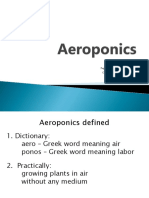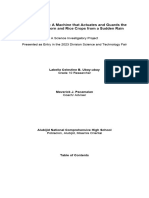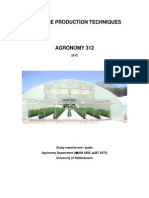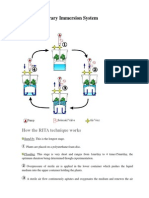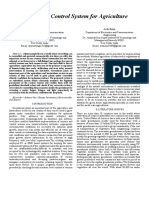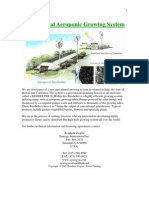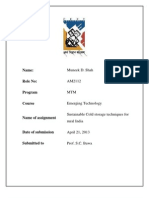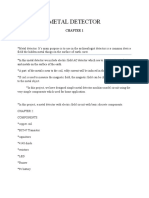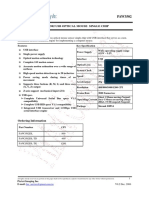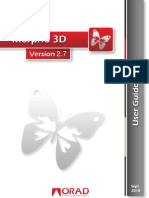In-Store Drying. The University of New South Wales Group Has Few Positive Things To Say About
In-Store Drying. The University of New South Wales Group Has Few Positive Things To Say About
Uploaded by
Nope NottodayCopyright:
Available Formats
In-Store Drying. The University of New South Wales Group Has Few Positive Things To Say About
In-Store Drying. The University of New South Wales Group Has Few Positive Things To Say About
Uploaded by
Nope NottodayOriginal Description:
Original Title
Copyright
Available Formats
Share this document
Did you find this document useful?
Is this content inappropriate?
Copyright:
Available Formats
In-Store Drying. The University of New South Wales Group Has Few Positive Things To Say About
In-Store Drying. The University of New South Wales Group Has Few Positive Things To Say About
Uploaded by
Nope NottodayCopyright:
Available Formats
In-store Drying.
The University of New South Wales group has few positive things to say about
the high temperature high airflow forced convection dryer that is favoured in Europe and the
United States. These systems have made it commercially feasible to dry grain in deep bins, with
low air volumes and very little supplemental heat. This dryer is used successfully in the
Australian grain industry. The UNSW group of Drs. Robert Driscoll and George Srednicki were
contracted by the Australian Centre for International Agriculture Research (ACIAR) to present
this industry experience in Southeast Asia. Drs. Justin Tumambing at NAPHIRE, Philippines,
and KMITT in Thailand, were the initial analysts. First they had to establish the thermophysical
properties of the most common modern rice varieties in the Philippines and Thailand such as
air-moisture balances with grain-moisture (note: grain-moisture equilibrium isotherms plotted
against relative humidity). NAPHIRE and KMITT reported substantial differences between the
southeast Asian varieties and the Australian varieties. Using pilot system dryers they
determined the required airflows to dry the grain to 14% wb within a period of time. Rather than
drying grain in a certain number of hours, time was reckoned in weeks. They concluded that the
very high initial moistures of 24% wb and above require first stage drying to minimize grain loss.
This yielded the two-stage drying strategy. First the high moisture grain had to be dried with a
high temperature, high airflow forced convection system (such as the Louisiana State University
{LSU} dryer), down to 18% wb. The more stable "dried" grain can then be loaded in bulk bins
and slowly dried to 14% wb with the low airflow, low heat system.
NAPHIRE developed a carriage-mounted continuous flow recirculating silk with a batch capacity
of ½ ton, to be used as a first stage dryer. It was assumed the dryer would be towed to the field
for grain drying immediately after threshing. The 18% wb grain could then be brought in to the
processing plant for final drying. The NAPHIRE strategy backfired when the government
approved the idea and politicians endorsed the mobile flash-dryer. NAPHIRE was
commissioned to implement the programme, which resulted in the manufacture of 2,000 flash-
dryers. Units were produced by local shops funded by congressmen and later distributed to farm
cooperatives. The farmers were unprepared and eventually furious. Coops were left with 18%
wb grain with no equipment to complete the 2-step drying process. Information gathered in a
survey conducted by Irene Villapando, Philippine Department of Agriculture consultant,
indicated that NAPHIRE's dryer was not being used because of technical, economic and
financial reasons. Further investigation prompted worldwide reactions. NAPHIRE's strategic
error was to aggressively promote the first stage of a two-stage drying procedure.. It
represented the risks faced in research and development.
You might also like
- Full Download Marine Protected Areas: Science, Policy and Management John Humphreys (Editor) PDFDocument64 pagesFull Download Marine Protected Areas: Science, Policy and Management John Humphreys (Editor) PDFletieravcin100% (4)
- 1.stripe Cashout MethodDocument1 page1.stripe Cashout Methodhoang tuan linh50% (2)
- Hydroponics ManualDocument22 pagesHydroponics ManualAbdullah Talib100% (2)
- Daikin Print Part ListDocument4 pagesDaikin Print Part ListPriesilia Presley100% (2)
- SOLAR DRYER v1Document43 pagesSOLAR DRYER v1Maria Angelica Borillo100% (1)
- Hoagland Arnon SolutionDocument32 pagesHoagland Arnon SolutionTommyTel1100% (1)
- 8-Step For Growth of Food Production by RCDohareDocument14 pages8-Step For Growth of Food Production by RCDoharercdohareNo ratings yet
- Greenhouse PDFDocument19 pagesGreenhouse PDFmehul rabariNo ratings yet
- Introduction-V1 5Document10 pagesIntroduction-V1 5kriza balNo ratings yet
- Vertical FarmingDocument21 pagesVertical FarmingSiddharth JainNo ratings yet
- Rice Tilipia and ChickenDocument19 pagesRice Tilipia and Chickenmelvin.a.casingalNo ratings yet
- Roberto PrincipeDocument5 pagesRoberto PrincipeRegie DequinaNo ratings yet
- Mechanical DryerDocument11 pagesMechanical DryerCharlyn Flores100% (1)
- Chapter 2Document10 pagesChapter 2Aanstein YalungNo ratings yet
- Battery Operated Paddy Dryer With Humidity Level SensorsDocument10 pagesBattery Operated Paddy Dryer With Humidity Level SensorsEm MendozaNo ratings yet
- Aeroponics 1 PresentationDocument101 pagesAeroponics 1 PresentationDR V S PATIL100% (3)
- Aeroponic Based Controlled Environment Based Farming SystemDocument4 pagesAeroponic Based Controlled Environment Based Farming SystemIOSRjournalNo ratings yet
- Design and Fabrication of Solar DryerDocument10 pagesDesign and Fabrication of Solar DryerAdeela Umar100% (1)
- DSTF 2Document26 pagesDSTF 2Heart EvangelistaNo ratings yet
- Automated Aeroponics System For Indoor Lettuce Farming Using ArduinoDocument23 pagesAutomated Aeroponics System For Indoor Lettuce Farming Using ArduinommgcelesteNo ratings yet
- E Important Fact: AgriculturDocument4 pagesE Important Fact: AgriculturNavdeep KhunteyNo ratings yet
- Group 10 Accomplishment ReportDocument5 pagesGroup 10 Accomplishment ReportJIMMY RETURANNo ratings yet
- Smart Integration in Agriculture An Arduino-DrivenDocument20 pagesSmart Integration in Agriculture An Arduino-DrivenLloyd MedenillaNo ratings yet
- Effect of Storage System and Sprout Removal On Post-Harvest Yam (Dioscorea SPP.) Fresh Weight LossesDocument9 pagesEffect of Storage System and Sprout Removal On Post-Harvest Yam (Dioscorea SPP.) Fresh Weight LossesM Fariz ZaklyNo ratings yet
- PS1 Chapter 123 FinalDocument30 pagesPS1 Chapter 123 FinalDrw ArcyNo ratings yet
- 2 Related LiteDocument5 pages2 Related Litemc archNo ratings yet
- EseuDocument6 pagesEseuPRAJINARIU OANA-GABRIELANo ratings yet
- Hydroponics PDFDocument151 pagesHydroponics PDFKancharla LaliteshNo ratings yet
- Final Feasibility Study Group 5Document18 pagesFinal Feasibility Study Group 5Germa Candela0% (1)
- 8.2 Vertical Farming and Hydroponics WORKSHEETDocument6 pages8.2 Vertical Farming and Hydroponics WORKSHEETcharan.mungamuruNo ratings yet
- Notas 2013 CDocument101 pagesNotas 2013 CJosh MentalNo ratings yet
- Chapter 1Document5 pagesChapter 1Anonymous 1VhXp1No ratings yet
- Greenhouse-Grown Cucumber As An Alternative To Field Production and Its Economic Feasibility in Aswan Governorate, EgyptDocument14 pagesGreenhouse-Grown Cucumber As An Alternative To Field Production and Its Economic Feasibility in Aswan Governorate, EgyptКанарейкаАрейкаNo ratings yet
- Integrated Ecological Agricultural Applications With AqacultureDocument19 pagesIntegrated Ecological Agricultural Applications With Aqaculturebahadir uguralNo ratings yet
- RRLDocument10 pagesRRLIan Parcon100% (4)
- RITA Temporary Immersion SystemDocument3 pagesRITA Temporary Immersion Systemelgibin100% (1)
- Green Bee Template-1Document4 pagesGreen Bee Template-1Aparna TyagiNo ratings yet
- 1807 8621 Asagr 41 E42706Document9 pages1807 8621 Asagr 41 E42706FADASDADSNo ratings yet
- 3marchrice NewsDocument56 pages3marchrice NewsMujahid AliNo ratings yet
- The Potential of Agroecology To Combat H PDFDocument4 pagesThe Potential of Agroecology To Combat H PDFJim MorrisonNo ratings yet
- Development and Promotion of The Reversible AirfloDocument14 pagesDevelopment and Promotion of The Reversible AirfloJohann TagadanNo ratings yet
- Research PaperDocument7 pagesResearch PaperNiña MaeyyNo ratings yet
- Novel Technologies From Around The GlobeDocument4 pagesNovel Technologies From Around The GlobeAnton LozanovNo ratings yet
- (Journal of Landscape Ecology) Opportunities and Challenges in Sustainability of Vertical Farming A ReviewDocument26 pages(Journal of Landscape Ecology) Opportunities and Challenges in Sustainability of Vertical Farming A ReviewKhairun NisaNo ratings yet
- Banana TCDocument16 pagesBanana TCtejaskamble45No ratings yet
- Fabrication of Solar Food Dryer Using Parabolic ReflectorDocument7 pagesFabrication of Solar Food Dryer Using Parabolic ReflectorannamalaiNo ratings yet
- The Real Green Revolution Organic and Agroecological FarmingDocument151 pagesThe Real Green Revolution Organic and Agroecological FarmingKlausEllegaard11No ratings yet
- Vertical Aeroponic Farming SystemDocument13 pagesVertical Aeroponic Farming Systemkocero790288% (8)
- grp2 Research ProposalDocument67 pagesgrp2 Research ProposalChristian V. SagaoNo ratings yet
- Reserach Vertical FarmingDocument4 pagesReserach Vertical FarmingJAN WESLEY MORIDONo ratings yet
- Cold Storage ReportDocument10 pagesCold Storage ReportMuneek ShahNo ratings yet
- BioChar Vertical Aeroponic Growing SystemsDocument18 pagesBioChar Vertical Aeroponic Growing SystemsMediaAJaboori100% (1)
- Greenhouse Economics: January 1990Document12 pagesGreenhouse Economics: January 1990Vincent John RigorNo ratings yet
- FarmingsFuture en 1 2016 SCREENDocument48 pagesFarmingsFuture en 1 2016 SCREENvenucoldNo ratings yet
- Growth and Physiological Characteristics of Rice Seedlings Raised With Long Mat by Hydroponics Comparison With Young Seedlings Raised in SoilDocument7 pagesGrowth and Physiological Characteristics of Rice Seedlings Raised With Long Mat by Hydroponics Comparison With Young Seedlings Raised in SoilAshik MahmudNo ratings yet
- Save and Grow: CassavaFrom EverandSave and Grow: CassavaRating: 5 out of 5 stars5/5 (1)
- Hydroponics for Beginners: Your Complete Guide to Growing Food Without SoilFrom EverandHydroponics for Beginners: Your Complete Guide to Growing Food Without SoilNo ratings yet
- Hydroponics For Beginners: The Beginner's Guide to Building a Sustainable and Inexpensive Hydroponic System at Home: Learn How to Quickly Start Growing Plants in WaterFrom EverandHydroponics For Beginners: The Beginner's Guide to Building a Sustainable and Inexpensive Hydroponic System at Home: Learn How to Quickly Start Growing Plants in WaterNo ratings yet
- Crop Production and Soil Management Techniques for the TropicsFrom EverandCrop Production and Soil Management Techniques for the TropicsNo ratings yet
- Vegetable Forcing - Containing Information on Greenhouse Construction, Management and Frame CultureFrom EverandVegetable Forcing - Containing Information on Greenhouse Construction, Management and Frame CultureNo ratings yet
- Hydroponics: Hydroponics Gardening Guide: From Beginner To Expert On Quickly Producing And Storing Delicious Natural Fruits, Vegetables, Berries And Spices From Your Own GardenFrom EverandHydroponics: Hydroponics Gardening Guide: From Beginner To Expert On Quickly Producing And Storing Delicious Natural Fruits, Vegetables, Berries And Spices From Your Own GardenNo ratings yet
- fs1 - Episode 14Document10 pagesfs1 - Episode 14Jamille Nympha C. BalasiNo ratings yet
- Jurnal 2 Asam Mefenamat 12 TahunDocument8 pagesJurnal 2 Asam Mefenamat 12 TahunMuhammad FirmansyahNo ratings yet
- IntegratingBIMTechnologyintoLA (2014) PDFDocument115 pagesIntegratingBIMTechnologyintoLA (2014) PDFArnaldo RuizNo ratings yet
- 05 Review 1Document1 page05 Review 1Marinel SantosNo ratings yet
- Metal DetectorDocument6 pagesMetal DetectorKasthuri.V kasthuri.VNo ratings yet
- TIME Module1Document22 pagesTIME Module1Dyavegowda PNo ratings yet
- Monitoring Tool For Quarterly TestDocument3 pagesMonitoring Tool For Quarterly TestAnna Dominique Daen100% (2)
- 71-00-00-710-005-B - Start AbortDocument2 pages71-00-00-710-005-B - Start AbortEder LucianoNo ratings yet
- Chipmouse Paw3502dl PDFDocument10 pagesChipmouse Paw3502dl PDFjjruttiNo ratings yet
- Vehicle Registration Search: Services (AOS)Document1 pageVehicle Registration Search: Services (AOS)Durga Prasad KadirireddyNo ratings yet
- Weekly Learning Activity Sheets General Physics 1 Grade 12, Quarter 2, Week 4Document4 pagesWeekly Learning Activity Sheets General Physics 1 Grade 12, Quarter 2, Week 4Shekaina Faith Cuizon Lozada100% (2)
- MRT SelectionDocument29 pagesMRT SelectionDaniel AriaNo ratings yet
- Non Line of Sight (NLOS)Document19 pagesNon Line of Sight (NLOS)Santhosh MadhuNo ratings yet
- Morpho3D2.8 - User GuideDocument114 pagesMorpho3D2.8 - User GuideJefferson FerreiraNo ratings yet
- Covumaiphuongbodevip2024 Deso46Document9 pagesCovumaiphuongbodevip2024 Deso46d.maitrang812No ratings yet
- Partner Profils - 2102 - Mananara - PREMIUM SPICESDocument2 pagesPartner Profils - 2102 - Mananara - PREMIUM SPICESRichade ChristianNo ratings yet
- OFNO White Sheet 032421Document8 pagesOFNO White Sheet 032421NA MENo ratings yet
- Counselling For Communication DisordersDocument6 pagesCounselling For Communication DisordersVINITAA A/P RAJAKUMARNo ratings yet
- How To Install OpenCV On Windows 7 - 8 (64bit) Using MinGW (64) and Codeblocks - Zahid HasanDocument6 pagesHow To Install OpenCV On Windows 7 - 8 (64bit) Using MinGW (64) and Codeblocks - Zahid HasanRichard AndradeNo ratings yet
- Quote To Cash SLA1Document34 pagesQuote To Cash SLA1psaikrishNo ratings yet
- Exp FADocument8 pagesExp FAcooljseanNo ratings yet
- Betaland Operation ConstraintsDocument4 pagesBetaland Operation Constraintsmuhammad kaleem100% (2)
- 2023 20241003BP5089Document58 pages2023 20241003BP5089harshika8054No ratings yet
- Cisco Network Modules OverviewDocument36 pagesCisco Network Modules Overviewadnane imedNo ratings yet
- Lecture 20 (Spring 17) : Applying Initial Conditions Using Fourier Series (Ch. 12.2 + 12.3)Document8 pagesLecture 20 (Spring 17) : Applying Initial Conditions Using Fourier Series (Ch. 12.2 + 12.3)shegufta_tahsinNo ratings yet
- HP TrueviewDocument12 pagesHP TrueviewozovoNo ratings yet
- Introduction To Battery Pack Design and Building, Part-2 PDFDocument18 pagesIntroduction To Battery Pack Design and Building, Part-2 PDFsnvvNo ratings yet















